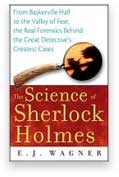It’s new to me: The Science of Sherlock Holmes review
 Originally I was a little skeptical about including The Science of Sherlock Holmes: From Baskerville Hall to the Valley of Fear, The Real Forensics Behind the Great Detective’s Greatest Cases into the references section of the website, but after having finished it I can now call it very worthy of inclusion, as long as you aren’t expecting a case-by-case analysis of the science of Sherlock Holmes, which I think could still be a very interesting book for Holmes scholars (fortunately the index will lead to the pages where the Canon is mentioned).
Originally I was a little skeptical about including The Science of Sherlock Holmes: From Baskerville Hall to the Valley of Fear, The Real Forensics Behind the Great Detective’s Greatest Cases into the references section of the website, but after having finished it I can now call it very worthy of inclusion, as long as you aren’t expecting a case-by-case analysis of the science of Sherlock Holmes, which I think could still be a very interesting book for Holmes scholars (fortunately the index will lead to the pages where the Canon is mentioned).
Author E.J. Wagner instead takes a categorical approach, devoting chapters to the advancement (and follies) of identification, ballistics and medicine as they pertain to criminal investigation. This is a great book if you want to read about those cases and stories that might have inspired Arthur Conan Doyle to write The Hound of the Baskervilles or the real-life detectives like Eugéne François Vidocq who may have taught Holmes a thing or two about disguises.
The book also includes cases that drew in Holmes’s creator, such the animal mutilations in the rural district of Great Wyrley, that were blamed on George Edalji, a young solicitor. The 1903 case had parallels with The Adventure of Silver Blaze, which was published in 1892, but author Wagner believes Doyle was attracted because of the injustice of the accusations against the dark-skinned solicitor of Asian descent. Doyle published a lengthy pamphlet defending Edalji (who had already been released after serving three years of a seven year sentence) but the man was never officially absolved.
Wagner also addresses the many famous cases that furthered or humiliated the science of criminal investigation, like the murders of Jack the Ripper (infamously investigators, fearing a public outcry, removed a graffito about “the Juwes” before it could be photographed); the scandal of the Tichborne Claimant (which showed the need for a systematic approach to criminal identification); the arrest of Dr. Crippen (accused of murdering his wife) after a transAtlantic chase and clever deductions by a ship’s captain; and of course the Dreyfus Affair, where a Jewish French officer was accused of leaking military secrets to the Germans. The Dreyfus Affair is particularly illustrative because a hero from a previous chapter, Alphonse Bertillon, who pioneered the science of anthropometry, becomes an enemy of science when he ventures into the field of handwriting analysis, a field of which he knew little. The Dreyfus Affair shows how criminal investigation advanced by fits and starts, with many failures among the successes.
I especially enjoyed the chapter A Voice in the Blood because of it’s connection with Holmes’ discovery of a test for hemoglobin (A Study in Scarlet) and the actual advances in the detection and identification (human vs animal) of blood. Overall, I found the book, copyright 2006 and in my library unread for years, a great nighttime read. Each chapter ends with some notes — Whatever Remains — about similar cases relating to the topic of that chapter, and there’s a very comprehensive bibliography.
